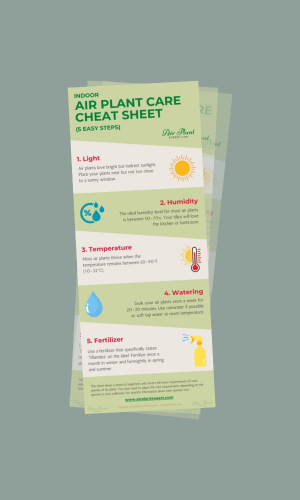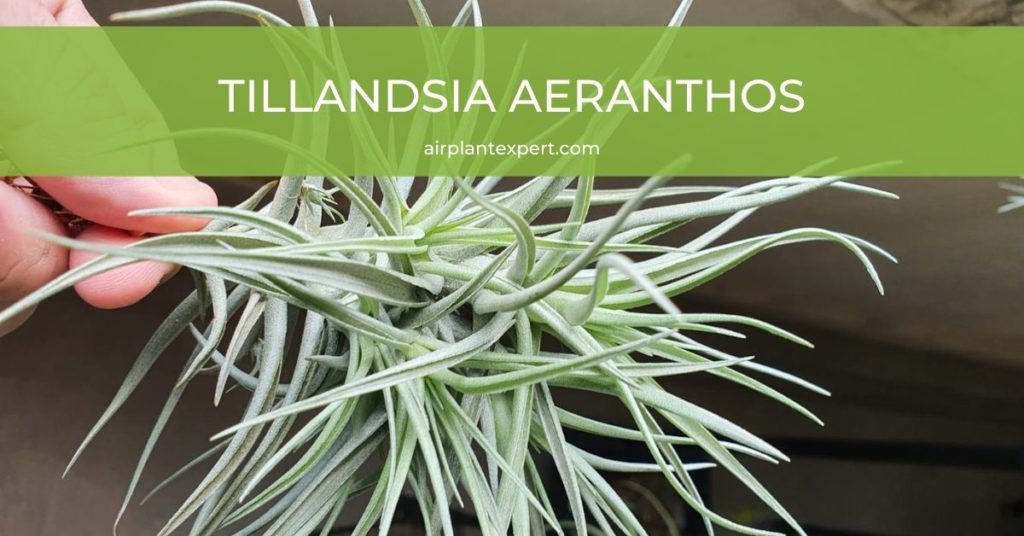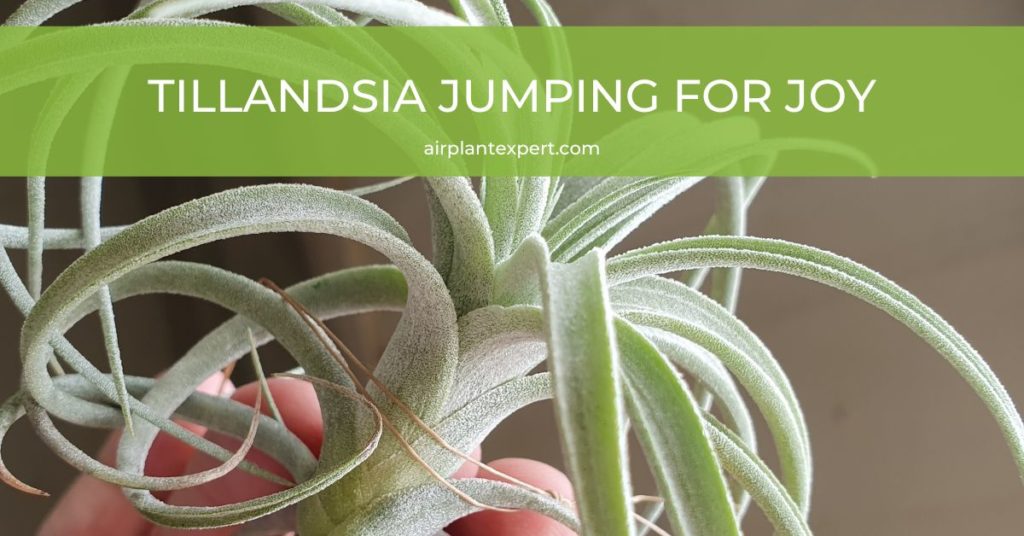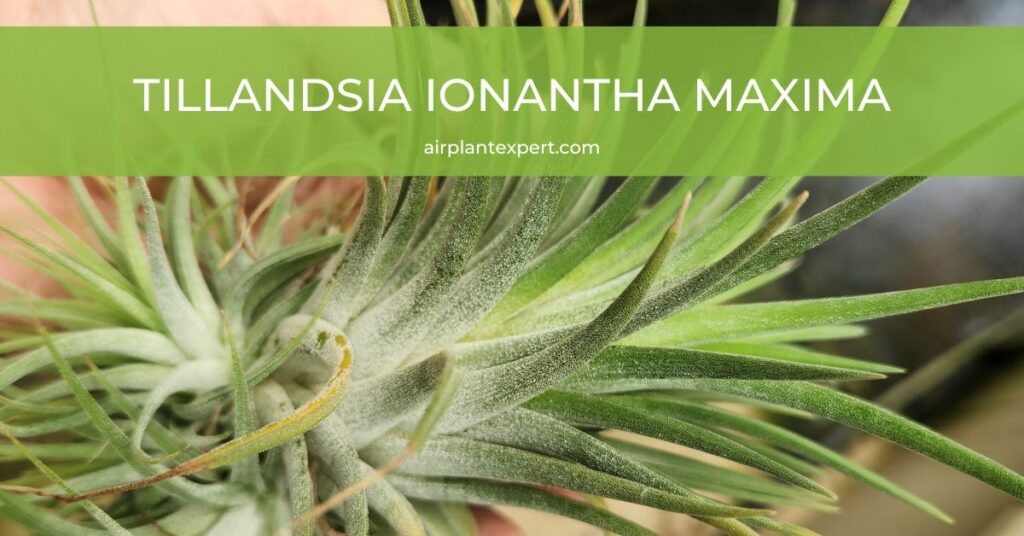Tillandsia Aeranthos has stiff, sharp leaves that grow upward in a cone-like fashion with a randomized rosette. It’s a reliable and spectacular bloomer and has a caulescent stem.
Quick Guide
How to Care for Tillandsia Aeranthos
Tillandsia Aeranthos requires bright indirect light, which can be achieved by placing it less than one foot away from a sunny window. The species is native to forests and therefore appreciates moderate to high humidity.
Aeranthos requires good air circulation, so opening a nearby window will do the trick if grown indoors. Fluctuations in room temperature shouldn’t be a problem as this species is very hardy.
Although a low-maintenance plant, it may benefit from occasional misting in dry conditions. However, this should not replace the watering method and schedule mentioned below.
While you can mount your plant on driftwood, I like to hang Aeranthos from a wire. This has several benefits such as aiding drying between waterings and easy nutrient applications. Also, when dangled, the cone-shaped leaves form an attractive display.
This species is welcomed by beginners and seasoned growers alike.
How to Water Tillandsia Aeranthos
Hydrating your Aeranthos is integral to proper growth. Submerge the plant in water (rainwater or soft tap water) for approximately 20-30 minutes once a week.
After soaking, shake off any excess water to help prevent rot. It’s best to water your plants in the morning to allow plenty of drying time before nightfall.
Your plant’s specific watering needs can vary based on the environmental factors in your home. Therefore, adjust your watering schedule as necessary to achieve the right balance for your plant, and mist as well as soak if you notice browning on the plant’s leaf tips, should they start to dry out.
Aeranthos naturally grow in clumps. You should allow larger clumps sufficient time to dry between waterings otherwise the clump will become susceptible to rotting very quickly.
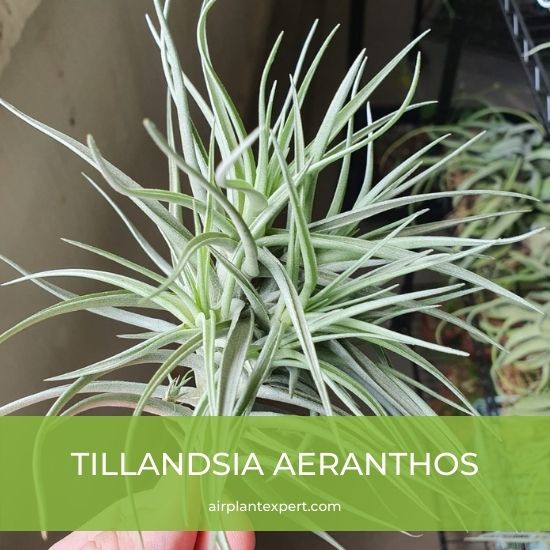
How to Propagate Tillandsia Aeranthos
The easiest way to propagate Tillandsia Aeranthos is to use the pup method, an approach that involves separating new baby plants from the parent plant.
After Aeranthos has flowered, you’ll notice small pups (or offsets) growing from the mother plant’s base. Once they’ve grown a few inches (or generally a third of the size of the mother plant), gently remove the pups by wiggling them by hand or by removing them with a sterile knife.
Allow the cut end of the pups to dry for a few hours and then place them in a new location. Proceed to mist them 2-3 a week during the first few weeks, and then care for them as you would a mature air plant.
Aeranthos usually produces 3-6 offsets, which should be enough, even for an addicted collector.

Get Your FREE Air Plant Care Cheat Sheet
5 easy steps to keep your air plants happy and healthy.
Flowers and Expert Tips
Tillandsia Aeranthos typically blooms in late spring/early summer and is quite simply a marvel to enjoy. In full bloom, the charismatic green foliage, paired with the spectacular flowering stalk/inflorescence is a sight to behold!
The floral bracts are stunning ruby-red and contrast well with the plant’s purple flowers. The flared petals are indigo-like in color. You won’t be disappointed by this awesome-looking plant. Also, the flowering cycle can last for 2 months so you’re in for a real treat.
This species should not be confused with Tillandsia Bergeri as their appearance in a non-blooming state is virtually indistinguishable. However, when in bloom Bergeri lacks Aeranthos’s ruby red floral bracts.
Tillandsia Aeranthos Hybrids
Tillandsia Aeranthos is native to parts of South America. Specifically, Uruguay, Brazil, Paraguay, and Argentina.
Its diversity is showcased through a spectrum of hybrids, each with unique characteristics. They vary primarily in size and leaf coloration, and their names often reflect these traits.
Such a wonderful collection of well-known hybrids:
- T. Aeranthos ‘Bergeri’ (Renowned for its robust growth)
- T. Aeranthos ‘Grey Ghost’ (Noted for its pale leaves)
- T. Aeranthos ‘Black’ (Distinct for its darker foliage)
- T. Aeranthos ‘Bronze’ (Identified by a hint of bronze in its leaves)
- T. Aeranthos ‘Purple’ (Exhibits purple-tinted leaves)
- T. Aeranthos ‘Amethyst’
- T. ‘Gordon C’
- T. Aeranthos Miniata (‘Mini Me’, ‘Mini Mini Me’)
- T. Aeranthos x Stricta
- T. Neglecta x Aeranthos.
Tillandsia Neglecta x Aeranthos is a Koide hybrid, created by air plant expert Pamela Koide. The inflorescence is very similar to Tillandsia Aeranthos and maintains its purple petals.

